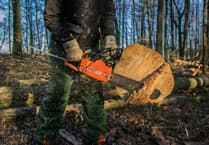THE owners of an internationally-renowned stud farm and equestrian centre have launched a new bid to convert a barn into accommodation, four years after losing an appeal for a four-bedroomed eco-house.
This time, the applicants hope to get permission for a holiday let with a music and art studio at the Losito Stud in Whitchurch.
A report on behalf of Karen Harris says planners have recently given permission for a solar farm next door, while the proposed holiday let will be part of the farm’s existing commercial buildings.
"There will be no adverse effect of the landscape as the holiday will sit next door to a solar panel farm which has been recently granted," it says.
Four years ago, Ms Harris lost her fight to replace a barn with an eco-house at the Wye Valley AONB site, which is beside the A4137 and Monmouth to Ross A40 dual carriageway.
Planners refused outline permission to pull down the barn and build a contemporary looking three-storey home, a decision that was backed on appeal the following year by the planning inspector.
The new application for the stud, which its website says is run by former Italian national showjumping team manager Giovanni Losito, says: "The site has been a well-established commercial equine business for over 11 years offering many activitiesâ?¦
"Herefordshire has become a sought-after tourist destination in recent years and following the recent pandemic with restrictions on international travel it is predicted there will be an increase in local tourism.
"It will be promoted as a destination for quality leisure visits and sustainable tourism by utilising, conserving and enhancing the county’s unique environment and heritage assets and by recognising the intrinsic character and beauty of the countryside."
The application says the holiday let would allow the business to offer riding and other themed-holidays.
It adds that the Wye Valley AONB office had no objection to the previous eco-house scheme, although planning inspector Hannah Porter ruled later: "The proposal would fundamentally harm the character and appearance of the countryside, as well as the landscape and scenic beauty of the AONB."
She said it would be visible from the road and nearby paths, and "would appear starkly at odds and harmfully out of place".
"The proposed dwelling would appear bulky and box-like, lacking any sense of lightness or design refinement," she added.
"It would not be of exceptional quality or of a suitably innovative nature to justify a new isolated home in the countryside."
Herefordshire planners had previously called the proposed home "unjustified, discordant, unsustainable new residential development of poor design, in the open countryside, that would be harmful to the character and appearance of the landscape."
Ms Harris claimed that she would have integrated the building within the natural landscape, increase bio-diversity by providing a wider range of habitats and follow the principles of "permaculture", producing no waste and harnessing and storing energy.
Ecological enhancements, such as wildflower planting to create "a species rich meadow" would support rare flowers such as orchids, the pasque flower and Cotswold pennycress, plus butterflies like the Chalkhill blue and Duke of Burgundy were also proposed.




Comments
This article has no comments yet. Be the first to leave a comment.